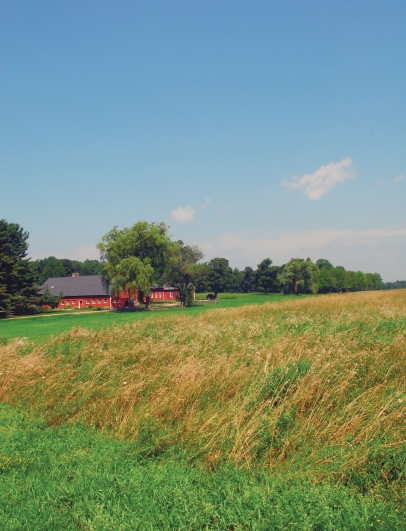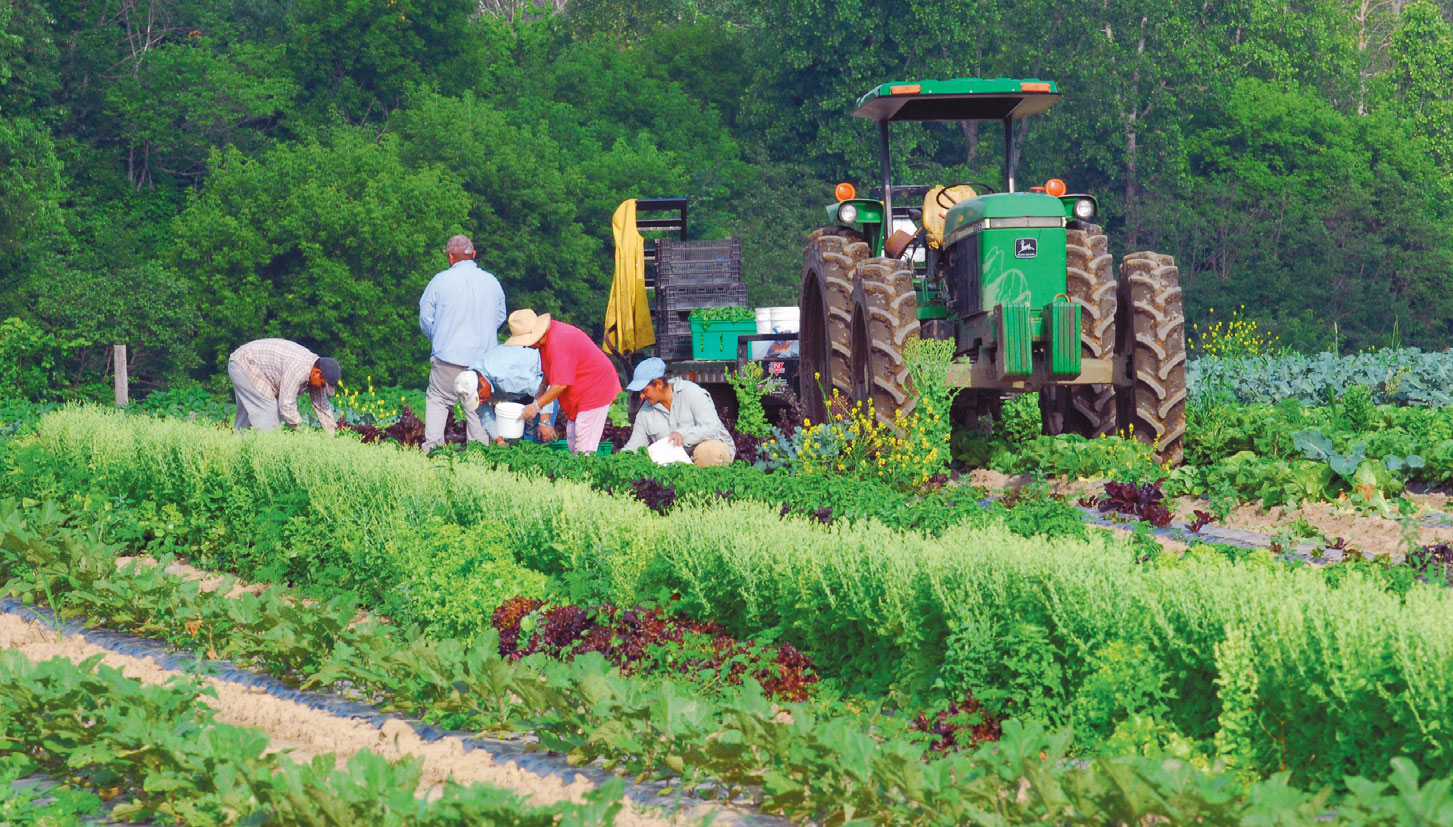A Primer on the 2018 Farm Bill

How federal policy will affect Jersey farmers and consumers
The Farm Bill has guided American agricultural policy since its creation in 1933. Part of the New Deal, it was designed to protect farmers and consumers when the twin forces of the Great Depression and Dust Bowl put the country’s food security at risk. Passed every five years, the bill includes 12 titles that cover everything from conservation to crop insurance. The 2014 Farm Bill, which encompassed roughly $457.5 billion in spending, expires on September 30, 2018. As the next iteration is drafted, the decisions made will affect us all.
The USDA has shared guiding principles with Congress in the run-up to the new bill. These range from building “a farm safety net that helps American farmers weather times of economic stress without distorting markets” to harnessing “America’s agricultural abundance to support nutrition assistance for those truly in need.” (Nutrition accounts for 80% of spending.)
The Garden State agricultural community is also weighing in. At the 2018 New Jersey Agricultural Convention, delegates adopted a resolution of Farm Bill priorities. Recognizing the diversity of our production and challenges related to labor, land and population density, it notes that our state “benefits from a strong emphasis on Specialty Crops Grants designed to increase consumer awareness about fresh produce, improve access to foreign markets, ensure food safety, strengthen research efforts, enhance conservation programs and encourage investment and efficiency.”
As to how all of this will translate into policy? That remains to be seen.
The Farm Bill is big. It’s complicated and updates have been slow-going. “I was just down in Washington last week and met with the American Farm Bureau,” said executive director of the New Jersey Agricultural Society, Al Murray, in late March. (He previously served as the state’s assistant secretary of agriculture.) “It seems like the Farm Bill keeps getting pushed back.”
The deadline looms, however. Whatever the result, this year’s Farm Bill will have far-reaching effects on the economy, the environment, our farms and the food on our plates. In a written statement, the New Jersey Department of Agriculture noted: “The Farm Bill is a vital piece of legislation that provides multiple benefits to New Jersey’s diverse agricultural community.”
“We need policies to take a long-term view and to stop putting short-term financial considerations ahead of what is necessary for our long-term survival.”
—Adrian Hyde, Executive Director of the Northeast Organic Farming Association of New Jersey

Hot Topics
The Farm Bill remains weighted toward the kind of large-scale, row-crop agriculture common in the country’s center. Yet, “it certainly impacts every farm in the nation,” Murray says, including in urban, northeastern states like ours. “The Farm Bill is a pretty wide sweeping bill of legislation,” he says. Carve-outs within the bill “help keep agriculture viable where we are, too.”
SNAP:
The Supplemental Nutrition Assistance Program has garnered plenty of headlines, from budget debates to proposed delivery boxes. In January 2017, more than 816,000 New Jersey residents benefitted, each receiving about $1.40 per meal. “That’s a very important program, particularly in an urban state like New Jersey,” Murray notes. “It is a reality with a big population that you are going to have an at-risk population.”
Farm to School:
This program advances nutrition education while forging ties between farms and schools. According to the 2015 USDA Farm to School census, 48% of New Jersey schools participated, reaching more than 342,000 students. Demand continues to far outstrip the $5 million in USDA grants awarded nationally. Yet, studies estimate that when schools procure locally, there is an economic multiplier effect of 1.4 to 2.6, meaning that for every dollar spent, up to $2.60 of local economic activity is generated.
WIC and Senior Farmers’ Market Nutrition Programs:
These provide free supplemental food, health referrals and nutrition education to nutritionally at-risk women, children and seniors. Participants can use food-assistance dollars to buy fresh produce from participating farmers’ markets, farm stands and CSAs.
Safety-net programs:
Subsidies largely support row crops, including here in New Jersey, if on a small scale. Farmers are compensated when prices fall below a reference price or revenue guarantee. In 2016, USDA data shows that Garden State farms received $4,582,000 from the Agriculture Risk Coverage (ARC) and Price Loss Coverage (PLC) programs, largely for corn and soy. Of a total of more than $80 billion spent that year, this equates to significantly less than 1%. According to the USDA’s Economic Research Service, New Jersey ranked 46th in direct farm program payments in 2016 overall.
Crop insurance:
In recent years, there has been movement to expand insurance coverage of so-called specialty crops (read: fruits and vegetables), but many remain ineligible. According to the USDA’s Economic Research Service, New Jersey ranked 40th in federal insurance indemnities in 2016, at a total of $4,326,000.
Disaster assistance:
Disaster-assistance programs are a growing area of spending, particularly for livestock operations not common here. Key programs for New Jersey include emergency loans and the Non-Insured Crop Disaster Assistance Program, which covers crops not eligible for primary insurance.
Farmland preservation:
In 2017, New Jersey received $3.5 million in funding for easements that permanently protect farms and wetlands against development. According to state conservationist Carrie Lindig of the New Jersey Natural Resources Conservation Service, funding has decreased since 2008, when it averaged $5 to $9 million.
Conservation:
$6.7 million in Environmental Quality Incentive Program grants for conservation investments went to Garden State farmers in 2017. In March, Senators Cory Booker (D-NJ) and Mike Lee (R-UT) introduced a bill that would better prioritize environmental and water-quality impact nationally, noting that over the eight years ending in 2016, “more than $1 billion—or more than 20% of EQIP funds—was spent on infrastructure practices that produce relatively little environmental benefit.”
Beginning farmers:
The Beginning Farmers and Ranchers Development Program helps new farmers acquire technical and business skills. Programs like the Rutgers Cooperative Extension’s Ultra-Niche Crop Series and Land Link website created by NOFA-NJ and the State Agricultural Development Committee have emerged through grant support. Federal loan programs also help new and existing farmers. In 2018, the USDA’s National Institute of Food and Agriculture (NIFA) announced approximately $17.7 million in grant funding to support organizations developing programming.
Specialty crop block grants:
Introduced in 2006, these bolster specialty crops. “It was the first time that produce, the sustenance that we eat, was ever supported in the federal government,” Murray says. “It actually brings money down to the grassroots level to allow individual groups to promote their product.” Funds are essential at a time when programs like Jersey Fresh, which Murray helped launch, have seen cuts. According to the 2018 New Jersey Farm Bureau Policy Book, its budget has gone from $1 million down to $50,000. At the State Agricultural Convention in February, Gov. Phil Murphy cited plans to “launch a new era” for the program.
Market Access Program (MAP):
MAP supports four national groups that work to open foreign markets. New Jersey is part of Food Expo USA. “These market-access funds aren’t for the major conglomerates, they’re for small companies,” Murray explains, noting New Jersey’s sizeable food-processing industry. Trade shows and selling missions have fed success stories—like a hot market for Atlantic County’s Tomasello Blueberry Wine in Japan.
Research:
Research funding fosters agricultural innovation related to food safety, climate change and beyond. Projects, administered through various programs, run the gamut. For example, the Rutgers Climate Institute is currently helping to develop a climate-change focused curriculum for northeast producers. In 2017, AeroFarms received a matching $1 million Seeding Solution grant from the Foundation for Food and Agriculture Research to work with Rutgers and Cornell scientists to study how stressors like light and humidity affect flavor.
Extension:
A resolution from the 2018 Agricultural Convention notes a trend in budgetary cuts to the Rutgers Agricultural Experiment Station, which has put constraints on personnel, research, extension activities and education. Adjusting for inflation, the state appropriation is 32% lower than it was ten years ago. “Exacerbating the funding cuts has been a threat that the federal formula funding for state agricultural experiment stations could be replaced with competitive grant funding only,” it states, urging stakeholders to communicate the need for stable federal funding to Congress.
Hemp:
The 2014 Farm Bill allowed for industrial hemp production. Legislation to enable research and agricultural production here is currently being pursued.

“The farmer spends a lot of up-front money—the seed, the fertilizer, the equipment, the fuel—and doesn’t get the return until after the crop has been harvested or sold.”
—Al Murray, executive director, New Jersey Agricultural Society
Support Is Critical for Small Farms, Produce, Organic
Market dynamics in the Garden State favor diversified farms that make the most of strong distribution networks and proximity to large population centers.
As Adrian Hyde, executive director of the Northeast Organic Farming Association of New Jersey (NOFA-NJ) notes, our farmers are much more likely to be feeding locals than animals, cars or faraway communities.
Still, there are challenges. “The structure of our agricultural economy is failing us in many ways, and smaller farmers are profoundly affected,” Hyde says, noting that the Farm Bill disproportionately bolsters large players. “For decades, small and diversified farms have been disappearing as large, monocrop farms take over. Major economic forces underlie this trend, which has accelerated since industrialization of agriculture began over 50 years ago.”
As such, support for fruits and vegetables remains a “rounding error” relative to row-crop subsidies. Yet, Hyde is optimistic that the bill could be rebalanced. “It’s one piece of legislation, but it serves many masters, and the different titles tend to be treated more or less distinctly. Where I see the greatest potential of the Farm Bill is in breaking down those silos and recognizing the very direct connections between human health and agricultural health.”
A bright spot is nutrition. The WIC Farmers’ Market Nutrition Program (and sister program for seniors) fosters vital links between people facing food insecurity and local growers. “Here, you have a program that literally checks every box at the same time,” Hyde says. “It recognizes the direct ties between the health of these populations and the food that they’re eating. It recognizes the benefit of making it possible to source this food locally from the farmers’ market. The money goes directly into the hands of local farmers.” Hyde also praises the Farm to School program, noting the lifetime dividends of nutrition programming overall.
As for organic? It’s up-and-coming. Cost-sharing for organic certification is in place, as are programs that help farmers make the organic transition. “A system that’s evolved in a certain way over a long period of time isn’t going to turn around on a dime,” Hyde says. Further investments could go a long way. “I think there’s more pressure to incorporate that into the legislation now that people see that this is what consumers really want.”
In 2017, NOFA-NJ was among 210 signers of a letter to the House Committee on Agriculture outlining the unsustainability of a monocrop system with numerous externalized costs—degraded soil, health epidemics, labor abuse, failing farms. The future, Hyde says, is in regenerative agriculture. “The letter shows in plain language that unchecked consolidation creates a race to the bottom.” Hyde praises the vision set out in Oregon Congressman Earl Blumenauer’s Food and Farm Act, which advocates for an overhaul that prioritizes health, innovation and eco-minded local production.
“Nearly every major issue we confront today can be tied back to our food system, including climate change,” Hyde says. “We need policies to take a long-term view and to stop putting short-term financial considerations ahead of what is necessary for our long-term survival.” Were that to happen, the Farm Bill could become less about how government fixes short-term problems, and more about who we wish to be as a nation.
Crop Insurance: Protection from Natural Disasters
Crop insurance has been in the Farm Bill since 1938, shielding farmers from risks associated with price fluctuations, yield deficits and natural disasters—the latter of which remains highly relevant in a coastal state where severe weather has been frequent. Farming is risky business.
“The farmer spends a lot of up-front money—the seed, the fertilizer, the equipment, the fuel—and doesn’t get the return until after the crop has been harvested or sold,” says Al Murray, executive director of the New Jersey Agricultural Society. “You get a hail storm, or, particularly the way this weather has been the last several years, crop insurance is imperative. It’s important that that program be fully funded.”
Still, the reach of primary insurance managed by the USDA Risk Management Agency (RMA) varies. According to the USDA’S 2016 New Jersey Crop Insurance Profile, 78% of soybean acreage was covered (78,123 acres), along with 72% of blueberries (6,564) and 65% of corn (52,189). Apples and potatoes, on the other hand, were only covered at 18% and 19%, respectively.
Some of this tracks to producers’ approaches to risk management. Yet, despite work to expand the range of crops eligible for RMA-based crop-insurance coverage, many producers remain shut out entirely. In recent years, alternatives have started to bridge the gap.
Expanded as a pilot in 2014, Whole Farm Revenue Protection insurance covers an entire farm under one policy, which can assist organic and diversified growers. Then there’s the Noninsured Crop Disaster Assistance Program (NAP). Administered by the Farm Service Agency since 1994, it’s available to anyone producing commercial crops for food, fiber or livestock consumption. Expanding the agricultural safety net, NAP was enhanced in 2014 to cover up to 65% of a given yield (previously 50%) at up to 100% of market price. Rules were also put in place to better align payouts to market value for organic growers, and to reach underrepresented farmers.
In 2015, applications more than doubled to 138,000 as a result, according to the National Sustainable Agriculture Coalition. Yet, the coverage doesn’t always address the scenarios that play out here. Take shellfish production: “NAP will only cover losses to a named storm, but our biggest problem is winter ice,” explains Matt Gregg of Forty North Oyster Farms and Barnegat Oyster Collective. “In the Barnegat Bay, when the wind blows hard west after a freeze, we are at serious risk of the ice crushing and destroying our oysters. This past winter was brutal. We saw the bay freeze fast and early; the entire industry was caught off guard and left exposed.”

What are commodity crops?
These include wheat, corn, sorghum, barley, oats, cotton, rice, peanuts, soybeans and oilseed.
What are specialty crops?
Better known as fruits and vegetables, these also include tree nuts, dried fruits and horticulture and nursery crops.
Communities Near You
What’s happening near you
Chef José’s 5-Course New Year's Eve Wine Pairing Dinner at Old York Cellars
Old York CellarsRingoes






